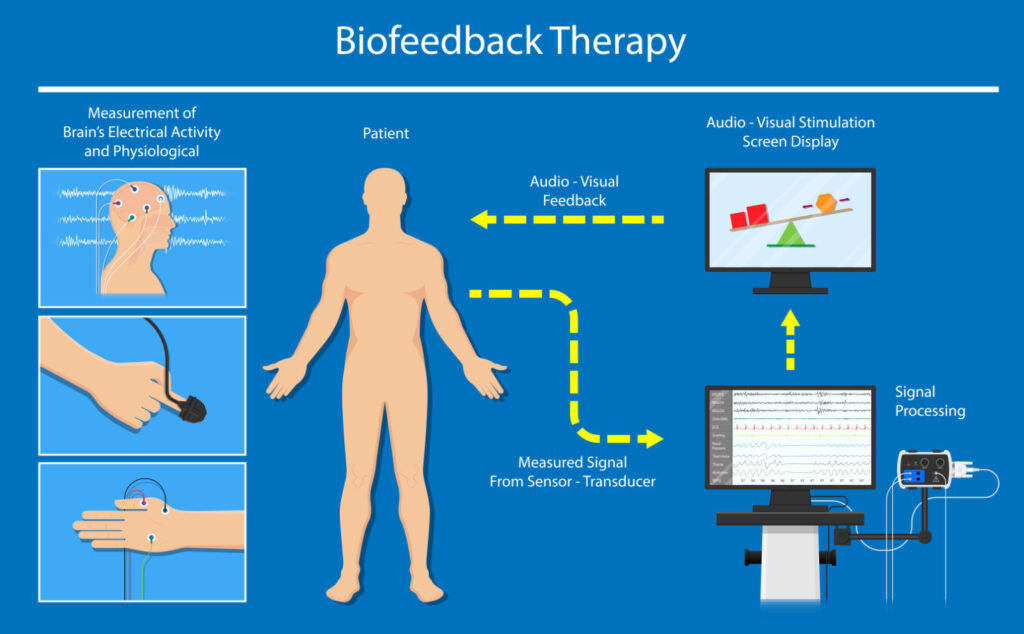
(From Mayo Clinic)
Biofeedback is a technique you can use to learn to control some of your body's functions, such as your heart rate. During biofeedback, you're connected to electrical sensors that help you receive information about your body.
This feedback helps you make subtle changes in your body, such as relaxing certain muscles, to achieve the results you want, such as reducing pain. In essence, biofeedback gives you the ability to practice new ways to control your body, often to improve a health condition or physical performance.
Types of biofeedback:
Your therapist might use a variety of biofeedback methods depending on your health problems and goals. Biofeedback types include:
- Brain waves. This type uses scalp sensors to monitor your brain waves using an electroencephalograph (EEG).
- Breathing. During respiratory biofeedback, bands are placed around your abdomen and chest to monitor your breathing patterns and respiration rate.
- Heart rate. This type uses finger or earlobe sensors with a device used to detect blood volume changes (photoplethysmograph). Or sensors placed on your chest, lower torso or wrists use an electrocardiograph (ECG) to measure your heart rate and how your heart rate varies.
- Muscle contraction. This type involves placing sensors over your skeletal muscles with an electromyograph (EMG) to monitor the electrical activity that causes muscle contraction.
- Sweat gland activity. Sensors attached around your fingers or on your palm or wrist with an electrodermograph (EDG) measure the activity of your sweat glands and the amount of perspiration on your skin, alerting you to anxiety.
- Temperature. Sensors attached to your fingers or feet measure blood flow to your skin. Because your temperature often drops when you're under stress, a low reading can prompt you to begin relaxation techniques.
Conditions treated:
Biofeedback, sometimes called biofeedback training, is used to help manage many physical and mental health issues, including:
- Anxiety or stress
- Attention-deficit/hyperactivity disorder (ADHD)
- Chemotherapy side effects
- Chronic pain
- Fibromyalgia
- Headache
- High blood pressure
- Irritable bowel syndrome
- Raynaud's disease
- Ringing in the ears (tinnitus)
- Stroke
- Temporomandibular joint disorder (TMJ)
Biofeedback appeals to people for a variety of reasons:
- It's noninvasive.
- It might reduce or eliminate the need for medications.
- It might enhance the benefits of medications.
- It might help women who can't take medication during pregnancy.
- It helps people feel more in control of their health.
Session structure:
During a biofeedback session, a therapist attaches electrical sensors to different parts of your body. These sensors might be used to monitor your brain waves, skin temperature, muscle tension, heart rate and breathing. This information is fed back to you via cues, such as changes on a monitor, a beeping sound or a flashing light.
The feedback teaches you to change or control your body's reactions by changing your thoughts, emotions or behavior. This can help the condition for which you sought treatment.
For instance, biofeedback can pinpoint tense muscles that are causing headaches. You then learn how to make deliberate physical changes in your body, such as relaxing specific muscles, to reduce your pain. The ultimate goal with biofeedback is to learn to use these techniques at home on your own.
A typical biofeedback session lasts 30 to 60 minutes. The length and number of sessions are determined by your condition and how quickly you learn to control your physical responses. Biofeedback might not be covered by insurance.
